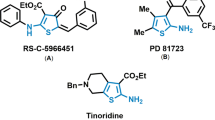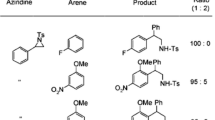Abstract
Symmetrical 2,5-disubstituted thiophene derivatives containing 1,3,4-oxadiazole moiety bearing different aromatic substitutions were synthesized by employing convenient and simple synthetic protocols using thiophene-2,5,dicarboxylic acid as a starting material. The structures of these target molecules were established by their analytical and spectral data. The photophysical and electrochemical studies were carried out on these compounds and found that they exhibit good fluorescent properties with high quantum yield.

Symmetrical 2,5-disubstituted thiophene derivatives containing the 1,3,4-oxadiazole moiety were synthesized from the corresponding thiophene 2,5-dicarboxylic acid. The Photophysical and electrochemical properties revealed that these compounds are good fluorescent materials with high quantum yield for OLED applications.


Similar content being viewed by others
References
Friend RH, Gymer RW, Holmes AB, Burroughes JH, Marks RN, Taliani C, Bradley DDC, Dos Santos DA, Bredas JL, Longdlund M, Salaneck WR (1999) Electroluminescence in conjugated polymers. Nature 397:121–127
Sirringhaus H (2005) Device physics of solution-processed organic field-effect transistors. Adv Mater 17:2411–2425
Brabec CJ, Sariciftci NS, Hummelen JC (2001) Plastic solar cells. Adv Funct Mater 11:15–26
Fichou D (2000) Structural order in conjugated oligothiophenes and its implications on opto-electronic devices. J Mater Chem 10:571–588
Shen Z, Burrows PE, Bulovic V, Forrest SR, Thompson ME (1997) Three-color, tunable, organic light-emitting devices. Science 276:2009–2011
Hosokawa C, Higashi H, Nakamura H, Kusumoto T (1995) Highly efficient blue electroluminescence from a distyrylarylene emitting layer with a new dopant. Appl Phys Lett 67:3853–3855
Zheng S, Shi J (2001) Novel blue-light-emitting polymers containing dinaphthylanthracene moiety. Chem Mater 13:4405–4407
Jacob J, Sax S, Piok T, List EJW, Grimsdale AC, Mullen K (2004) Ladder-type pentaphenylenes and their polymers: efficient blue-light emitters and electron-accepting materials via a common intermediate. J Am Chem Soc 126:6987–6995
Anderson S, Taylor PN, Verschoor GLB (2004) Benzofuran trimers for organic electroluminescence. Chem Eur J 10:518–527
Jin SH, Kim MY, Kim JY, Lee K, Gal YS (2004) High-efficiency poly(p-phenylenevinylene)-based copolymers containing an oxadiazole pendant group for light-emitting diodes. J Am Chem Soc 126:2474–2480
Brunner K, Dijken AV, Borner H, Bastiaansen JJAM, Kiggen NMM, Langeveld BMW (2004) Carbazole compounds as host materials for triplet emitters in organic light-emitting diodes: tuning the HOMO level without influencing the triplet energy in small molecules. J Am Chem Soc 126:6035–6042
Wang C, Jung GY, Hua Y, Pearson C, Bryce MR, Petty MC, Batsanov AS, Goeta AE, Howard JAK (2001) An efficient pyridine- and oxadiazole-containing hole-blocking material for organic light-emitting diodes: synthesis, crystal structure, and device performance. Chem Mater 13:1167–1173
Zhan X, Liu Y, Wu X, Wang S, Zhu D (2002) New series of blue-emitting and electron-transporting copolymers based on fluorene. Macromolecules 35:2529–2537
Lee YZ, Chen X, Chen SA, Wei PK, Fann WS (2001) Soluble electroluminescent poly(phenylene vinylene)s with balanced electron- and hole injections. J Am Chem Soc 123:2296–2300
Chung SJ, Kwon KY, Lee SW, Jin JL, Lee CH, Lee CE, Park Y (1998) Highly efficient light-emitting diodes based on an organic-soluble poly(p-phenylene- vinylene) derivative carrying the electron-transporting PBD moiety. Adv Mater 10:1112–1116
Kim JH, Park JH, Lee H (2003) Highly efficient novel poly(p-phenylene -vinylene) derivative with 1, 3, 4-oxadiazole pendant on a vinylene unit. Chem Mater 15:3414–3416
Zhu WH, Yao R, Tian H (2002) Synthesis of novel electro-transporting emitting compounds. Dyes Pigm 54:147–154
Skene WG, Guarìn Sergio Andres Perez (2007) Spectral characterization of thiophene acylhydrazides. J Fluoresc 17:540–546
Balaganesan B, Shen W, Chen CH (2003) Synthesis of t-butylated diphenylanthracene derivatives as bluehost materials for OLED applications. Tetrahedron Lett 44:5747–5750
Kloepfer JA, Cohen N, Nadeau JL (2004) FRET between CdSe quantum dots in lipid vesicles and water- and lipid-soluble dyes. J Phys Chem B 108:17042–17049
Bryantseva NG, Sokolova IV, Tsyrenzhapova AB, Selivanov NI, Khilya VP, Garazd YL (2008) Fluorescent characteristics of coumarin photosensitizers. J Appl Spectrosc 75:701–705
Datta GK, Guha S, Patil S (2010) Synthesis of liquid crystalline benzothiazole based derivatives: a study of their optical and electrical properties. Org Electron 1:11–19
Acknowledgements
The authors thanks the Karnatak University, Dharwad, and University Grants Commission (UGC), New Delhi, India, for financial support and thankful to the University Science Instruments Centre, Karnatak University, Dharwad, for providing the spectral data.
Author information
Authors and Affiliations
Corresponding author
Rights and permissions
About this article
Cite this article
Panchamukhi, S.I., Belavagi, N., Rabinal, M.H. et al. Synthesis and Optoelectronic Properties of Symmetrical Thiophene Based 2,5-disubstiuted 1,3,4-oxadiazoles: Highly Fluorescent Materials for OLED Applications. J Fluoresc 21, 1515–1519 (2011). https://doi.org/10.1007/s10895-011-0838-y
Received:
Accepted:
Published:
Issue Date:
DOI: https://doi.org/10.1007/s10895-011-0838-y




